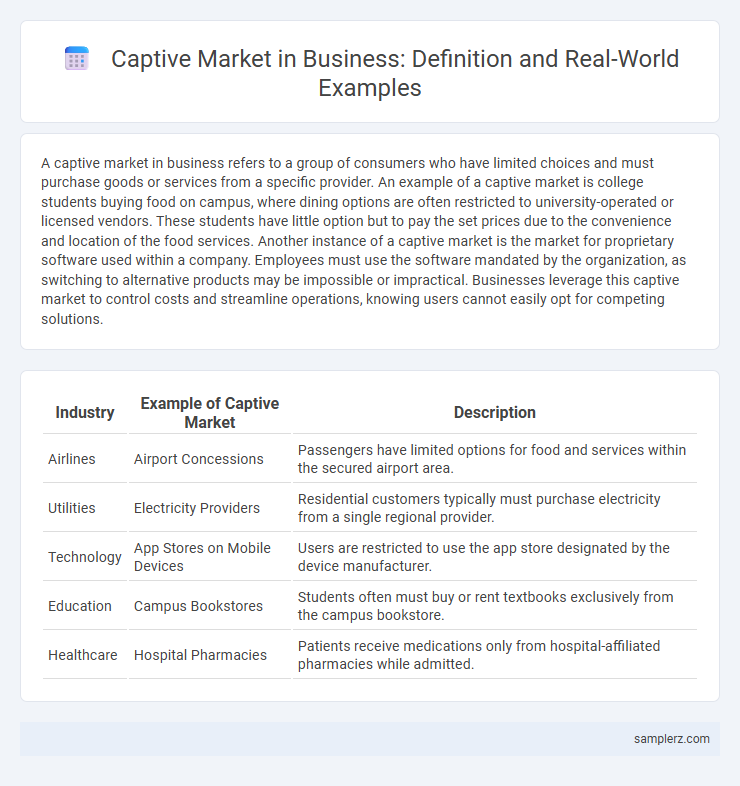A captive market in business refers to a group of consumers who have limited choices and must purchase goods or services from a specific provider. An example of a captive market is college students buying food on campus, where dining options are often restricted to university-operated or licensed vendors. These students have little option but to pay the set prices due to the convenience and location of the food services. Another instance of a captive market is the market for proprietary software used within a company. Employees must use the software mandated by the organization, as switching to alternative products may be impossible or impractical. Businesses leverage this captive market to control costs and streamline operations, knowing users cannot easily opt for competing solutions.
Table of Comparison
| Industry | Example of Captive Market | Description |
|---|---|---|
| Airlines | Airport Concessions | Passengers have limited options for food and services within the secured airport area. |
| Utilities | Electricity Providers | Residential customers typically must purchase electricity from a single regional provider. |
| Technology | App Stores on Mobile Devices | Users are restricted to use the app store designated by the device manufacturer. |
| Education | Campus Bookstores | Students often must buy or rent textbooks exclusively from the campus bookstore. |
| Healthcare | Hospital Pharmacies | Patients receive medications only from hospital-affiliated pharmacies while admitted. |
Understanding Captive Markets in Business
A prime example of a captive market in business is airline food services, where passengers have limited alternatives and must purchase meals from the airline. Another instance includes college bookstores that sell required textbooks to enrolled students, who rely on this exclusive source for course materials. Understanding captive markets helps businesses tailor pricing and product offerings to consumers with restricted choices, maximizing profitability within these controlled environments.
Key Characteristics of Captive Markets
Captive markets exhibit limited consumer choice due to exclusive supplier control or geographic isolation, often leading to inelastic demand. Key characteristics include high barriers to entry, restricted competition, and predictable customer loyalty, exemplified by utility companies serving regulated local areas. These markets allow businesses to maintain stable prices and consistent revenue streams by relying on captive customer bases with few alternatives.
Airline Food Services: A Classic Captive Market Example
Airline food services represent a classic captive market where passengers have limited alternatives due to the confined environment and limited onboard options. Airlines capitalize on this captive market by offering exclusive meal options at premium prices, often bundled with ticket purchases or sold during flights. This market dynamic enables airlines to generate substantial ancillary revenue from food and beverage sales despite the typically high costs of in-flight catering.
University Campus Bookstores and Monopolized Sales
University campus bookstores exemplify a captive market where students and faculty have limited purchasing options due to exclusive agreements between universities and bookstore operators. These monopolized sales channels restrict competition, often resulting in higher prices for textbooks, supplies, and university-branded merchandise. The lack of alternative vendors on campus solidifies the bookstore's control over the market, leveraging captive consumer demand.
Utilities Providers: Power & Water Supply as Captive Markets
Utilities providers in power and water supply represent classic captive markets due to limited competition and high entry barriers. Customers rely exclusively on these essential services, ensuring stable demand and predictable revenue streams for providers. Regulatory frameworks often reinforce this captive status by granting exclusive rights within specific geographic areas.
Prison Commissaries and Limited Consumer Options
Prison commissaries represent a prime example of a captive market where incarcerated individuals have restricted consumer options and must purchase goods exclusively from the facility's designated providers. This limited competition allows commissaries to set higher prices on everyday items such as snacks, toiletries, and writing supplies, capitalizing on the lack of alternative retail sources. The unique economic environment of prison commissaries highlights the challenges and ethical considerations inherent in captive market dynamics within the business landscape.
Stadium Concessions: Exclusive Selling Rights
Stadium concessions operate as a prime example of a captive market by granting exclusive selling rights to select vendors, limiting consumer choices within the venue. These vendors benefit from guaranteed customer access, often resulting in higher prices and limited competition. Such exclusive agreements maximize revenue for stadium owners while controlling the food and merchandise options available to attendees.
In-Flight Entertainment and Wi-Fi Services
In-flight entertainment and Wi-Fi services represent a classic example of a captive market, as passengers on flights are limited to the available providers during their journey. Airlines typically partner with specific technology companies like Gogo or Panasonic Avionics to offer exclusive access to streaming, gaming, and connectivity options. This exclusivity allows providers to control pricing and content choices, capturing a dedicated customer base without competition in that confined environment.
Cable and Internet Providers in Restricted Regions
Cable and internet providers in restricted regions create captive markets by limiting consumer choices through exclusive service agreements and lack of alternative competitors. High infrastructure costs and regulatory barriers reinforce this monopoly, forcing residents to accept higher prices and fewer service options. These conditions attract significant revenue for providers while restricting market competition and consumer bargaining power.
Pharmaceutical Sales in Hospital Settings
Pharmaceutical sales in hospital settings represent a classic example of a captive market where hospitals often have exclusive contracts with specific drug suppliers, limiting competition. These contracts ensure consistent demand for chosen pharmaceuticals but restrict alternative suppliers from entering the market. Such arrangements maximize supplier control and optimize inventory management within the healthcare institution.

example of captive market in business Infographic
 samplerz.com
samplerz.com